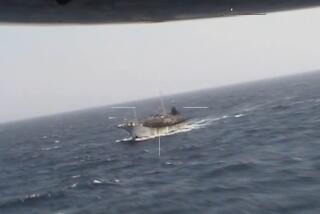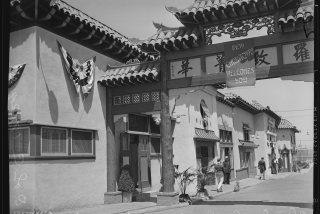China ‘Sin City’ Is Duller Now for U.S. Navy
- Share via
QINGDAO, China — When Gilbert Luna served in the U.S. Navy here in 1946, this port city along the East China coast was known to American servicemen as “the Sin City of the Orient.”
“Qingdao was high living for Americans. There were private beaches. The girls were lined up waiting right outside the military compound in rickshaws,” Luna, 58, who was then a teen-aged seaman just out of boot camp, recalled in a recent telephone interview. Luna now works for the real estate division of the Los Angeles Department of Public Works.
“There were kids with wads of money, 6 years old, who would buy your blankets or dirty clothing. Anything that wasn’t nailed down was stolen and resold on the black market. Any Chinese who came into the barracks, we’d pull out a gun and count ‘One, . . . two, . . . three.’ If they didn’t understand English, they were in trouble.”
Sounds of Mortar Fire
The American contingent of 2,500 Marines and 600 naval personnel was confined within Qingdao and a perimeter approximately 20 miles outside the town (then known, under a different system of spelling, as Tsingtao). From outside this perimeter, they could sometimes hear the mortar fire from the Chinese civil war between the Nationalists and Communists. Finally, in November, 1948, with Communist troops moving steadily southward through China, the U.S. forces withdrew.
Now, the U.S. Navy is about to return to Qingdao--at the invitation of the same People’s Liberation Army whose offensive drove it out of the port city 38 years ago.
Next Wednesday, three U.S. warships are scheduled to sail into Qingdao (pronounced Ching Dow), which has one of the best deep-water harbors in northern China, to begin what the United States and China are terming “a friendly, courtesy port call,” the first by the Navy to China since the Communist takeover in 1949.
During the six-day stay, Adm. James A. Lyons Jr., commander in chief of the U.S. Pacific Fleet, will be entertained at a banquet by leaders of the People’s Liberation Army, the Chinese military. And some of the nearly 1,000 American naval personnel will make recreational visits to inland sites such as Qufu, the birthplace of Confucius, which was outside the perimeter of safety the last time the Navy was here.
The Navy will find life in Qingdao utterly transformed over the past four decades. No one would call this the Sin City of the Orient any more. It is a pleasant, quiet but dull seaside town, as staid as a church social but without too many churches, either.
No Dance Halls, Nightclubs
Night life? After six nights in Qingdao, those American sailors who like wine, women and song will be yearning for livelier Asian locales such as Subic Bay in the Philippines.
“We don’t have any dance halls or nightclubs for commercial purposes. Factories or work units can organize dances, but only for recreation,” Wang Yuchang, 54, who has served as director of propaganda for Qingdao’s Communist Party for most of the last 35 years, informed foreign correspondents recently.
“If you started dance halls or bars for commercial purposes, there would have to be a class of professional girls with whom you could dance,” Wang explained. “And that creates problems.”
The propaganda chief admitted there is not too much cultural life in Qingdao, either.
As for church socials, Qingdao’s churches have changed, too. Four decades ago, Qingdao’s Gothic-style Catholic cathedral, built in 1934 and presided over by a bishop, was once the center of Roman Catholic religious activity throughout much of northern China.
Church Was Wrecked
The church was almost destroyed during the 1966-76 Cultural Revolution and was not rebuilt until four years ago. Religious services are now being permitted there once again, but only under the auspices of China’s Patriotic Catholic Church, a Communist Party-controlled national organization that is required to forswear allegiance to the Pope and the Vatican.
Asked whether baptisms are still performed there, a church official replied, “not any more. In China, it is not necessary, because we don’t believe in original sin.”
Crime? During the late 1940s, in the last frenetic years of the civil war, Luna recalled, life was cheap. “Up at the (Nationalist government) police barracks, you could see them dumping dead bodies outside, and before the corpses could get taken away, people would take the clothes off them. It was not much of a time for civil liberties,” he said.
These days, Qingdao Mayor Guo Songnian says Qingdao’s biggest crime problems are street brawls and petty thefts.
“We have thefts, robberies, even a homicide, but not so much that individuals here become afraid,” he said. “These are isolated incidents.”
European-Style Houses
The pretty, stately old European-style homes along the water, built by the Germans when they seized Qingdao at the beginning of this century and later occupied by the Americans in the late 1940s, are still standing, though many of them are in disrepair.
The nicest of them, the former mansion of the German governor of Qingdao, was once taken over by Mao Tse-tung and his wife, Jiang Qing, for a beachside vacation. Now, three of the old European homes are being turned over to foreign businessmen who have recently come with their families to work in Qingdao.
Qingdao is desperate to attract foreign capital. Mayor Guo has traveled to Singapore and Europe in search of potential investors, and other Qingdao officials will soon be traveling on a similar mission to the United States.
The mayor believes that the city must further develop its textiles and light industries. Qingdao houses one of China’s most important naval and submarine bases and serves as a center for oceanographic research, but Guo says the naval presence does not really help the local economy.
“It’s different from other countries,” the mayor told foreign correspondents over lunch recently. “The military has a port here, but it doesn’t bring us any money.”
Symbol of Cooperation
The U.S. Navy’s scheduled visit to Qingdao is being widely viewed as a symbol of the widening military cooperation between the United States and China in response to the increasing Soviet naval presence in the Pacific.
Last summer, North Korea reportedly agreed for the first time to Soviet naval ships visiting the port of Nampo on the west coast of the Korean Peninsula--just over 200 miles across the Yellow Sea from the East China coast at Qingdao. Until this summer, Soviet ships were allowed to call only at the port of Wonsan, on North Korea’s eastern coast.
A year ago, discussions of a possible U.S. Navy port call to China had focused upon Shanghai, China’s largest city, which is much farther down the coast. The shift to Qingdao will bring the Navy ships considerably nearer to North Korea. (China does have one other large naval port still farther north, at Lushun outside the city of Dalian.)
The three visiting U.S. warships will be the 530-foot guided missile cruiser Reeves, which carries anti-aircraft missiles; the 560-foot destroyer Oldendorf, an anti-submarine ship carrying helicopters and torpedoes, and the 450-foot guided missile frigate Rentz, which is used both for anti-aircraft and anti-submarine warfare. U.S. and Chinese officials have not explained how they settled an earlier dispute over the U.S. policy of not saying whether ships carry nuclear weapons.
Peaked at 113,000 Men
At the end of World War II, the reason given for sending the U.S. Navy to Qingdao was similar to that cited now: The U.S. forces were said to be serving as protection against possible moves southward in Asia by the Soviet Union.
There were also detachments of American military forces in Peking, Tianjin, Nanjing and Shanghai in the mid to late 1940s. At its peak, at the end of 1945, the U.S. troop strength in China was about 113,000 men.
A year later, after American efforts to mediate between the Nationalist government of Chiang Kai-shek and Mao’s Communist forces had failed, the U.S. armed strength was cut back to 12,000. But the Navy stayed on in Qingdao and a military advisory group remained in Nanjing.
President Harry S. Truman insisted that the United States did not intend to take sides between the Nationalists and Communists. “While avoiding involvement in their civil strife, we will persevere with our policy of helping the Chinese people to bring about peace and economic prosperity in their country,” he declared.
Nevertheless, some American critics of Truman’s policy complained that the United States was in effect aiding Chiang’s Nationalist forces against the Communists by providing them with military equipment, supplies and advisers. (Other critics in the United States complained that the Truman Administration was not providing enough help to Chiang.)
To Counter Soviet Moves
In Qingdao, Luna recalled, U.S. troops were told that their main mission was to protect the port from any possible intervention by Soviet military forces. In addition, he said, “we had a small detachment helping the Nationalists’ navy.”
Qingdao also served as a staging area for Nationalist troops heading northward to Manchuria.
At the time, Luna said, Qingdao had a cosmopolitan atmosphere. Its inhabitants, for example, included a large colony of Russian immigrants. “We (U.S. Navy personnel) took over several hotels, former Japanese schools, warehouses, dock facilities, and the airport,” he said.
The city offered the sailors nightclubs, gambling joints and a race track. For those who liked more adventurous sorts of speculation, there were also black markets and shady currency transactions, fueled by what is believed to have been the worst inflation in the history of the world.
China’s wholesale price index, based on a level of 1 in 1937, was 16.8 million at the end of 1947 and 21.6 trillion at the end of 1948.
“Some of the (U.S.) Air Force pilots would buy currency in Shanghai and fly it up to Peking to make money. There were different quotes in the two cities,” Luna said.
Land Travel Was Restricted
But all travel was by sea or air. In those days, U.S. naval personnel were not allowed to travel overland even as far as Laoshan, the mountain barely 25 miles outside the city which has a Taoist temple and China’s most famous mineral water.
The sailors who arrive Wednesday will find Qingdao a far more tranquil place.
Because of its location on the Yellow Sea, Qingdao remains one of the main resort attractions in North China. On a typical day, Qingdao factory workers, sailors and cadres take long lunches to meander down the beach alongside tourists from other parts of China and abroad.
Over the last four decades, Qingdao has also become a heavily industrialized city, one of the 15 largest in China. The smoke from its factories blows quickly down to the oceanside villas. Only a few miles’ drive from the scenic beaches are blighted urban areas as ugly and polluted as any along the New Jersey Turnpike near Newark.
For sentimental reasons, Luna, who left Qingdao in 1947, returned as a tourist in 1978 to see what was left of the turbulent city of sin he had once known.
“It was like going back to the twilight zone,” he said.
More to Read
Sign up for Essential California
The most important California stories and recommendations in your inbox every morning.
You may occasionally receive promotional content from the Los Angeles Times.













